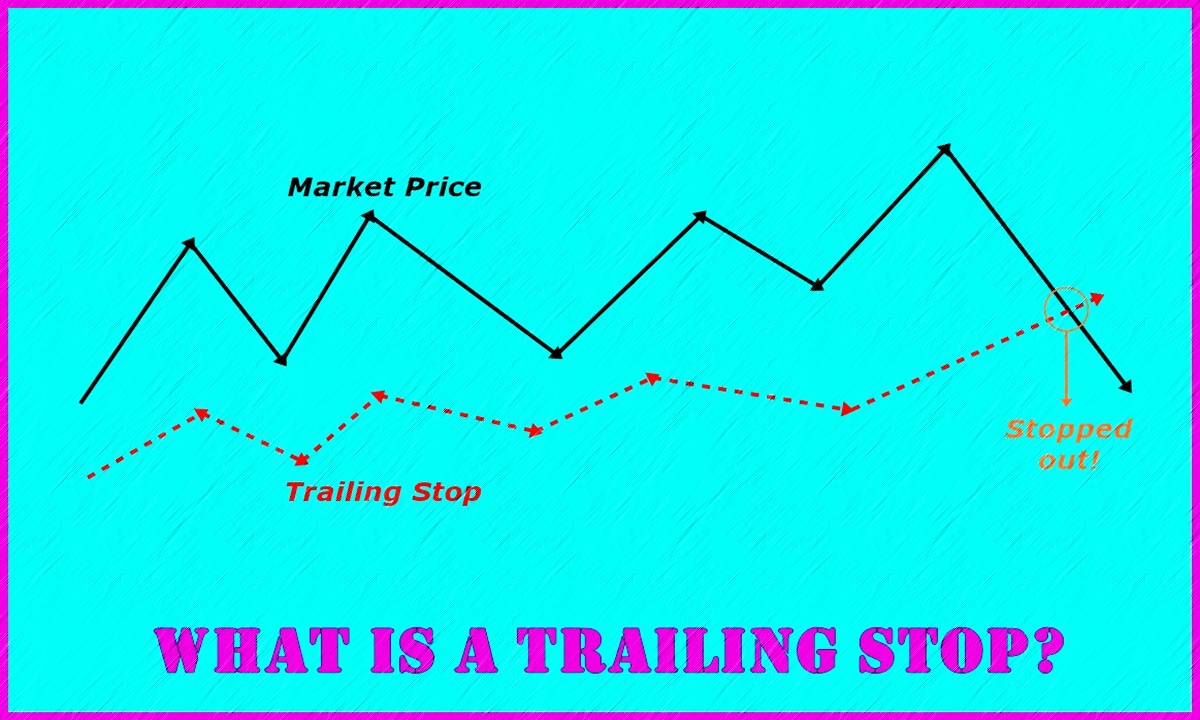Table of Contents
Overview
Managing risks while trading cryptocurrency is of utmost importance for any trader. One effective tool to achieve this is a trailing stop order, which allows traders to limit losses and secure profits as the market fluctuates. Unlike a traditional stop order, a trailing stop adjusts dynamically with the market price, providing flexibility and the opportunity to capitalize on favorable movements. Traders can use trailing stop orders in various markets and trading platforms, making it a valuable addition to their strategies. This article explains what a Trailing Order is and how it can be used effectively by traders.
What is a Trailing Stop Order?
A trailing stop order is a type of order that enables traders to safeguard their gains and minimize losses by placing a pre-set order at a specific percentage away from the current market price. Unlike a traditional stop order that remains fixed, a trailing stop order adjusts dynamically as the price moves in the trader’s favor. This flexibility empowers traders to continue capitalizing on favorable market movements while protecting their accumulated profits.
Why Should I Use a Trailing Stop Order?
When it comes to maximizing your trading and investing strategies, a trailing stop loss can be a game-changer. Unlike a conventional stop-loss order, which relies on a fixed dollar amount, a trailing stop adjusts dynamically with the market, offering a more flexible and effective approach. Whether you’re trading stocks, options, or futures, incorporating a trailing stop into your arsenal can yield significant advantages.
The key distinction of a trailing stop lies in its ability to adapt to market fluctuations. Instead of being bound by a static price point, a trailing stop is set at a certain percentage or dollar amount below the current market price. As the market moves in your favor, the trailing stop automatically adjusts, keeping you protected while allowing for potential gains. This feature is particularly valuable for long positions, where you can secure profits as the market rises.
By utilizing a trailing stop, you can maintain a balance between capitalizing on upward movements and protecting against sudden downturns. This dynamic approach minimizes the impact of emotional decision-making, allowing you to stay disciplined and objective. The constant revision of the trailing stop ensures that you’re always well-positioned to capture profits, while effectively managing risk.
Moreover, the versatility of trailing stops extends to various trading platforms that support traditional stop-loss orders. Whether you’re trading stocks, options, or futures, you can take advantage of this powerful tool to optimize your trading strategies across different markets.
How Does a Trailing Stop Order Work?
Placing a Trailing Stop Order
Traders commonly use trailing stop orders after they have entered a position, rather than during the initial trade entry. This approach allows them to manage risk and secure gains effectively. For a long trade, a sell trailing stop order is utilized, while a buy trailing stop order is employed for short trades.
Long Trades and Sell Trailing Stop Orders
When entering a long trade, a sell trailing stop order is placed above the current market price. The trailing stop price is then adjusted upwards by a specified percentage or amount, in line with the market price movements that favor the trader. Essentially, the trailing stop price trails the market price, ensuring that the specified distance is maintained.
Should the market price reverse and move against the trader, triggering a downward movement, the trailing stop order will cease to adjust. Consequently, if the market price falls below the trailing stop price, a sell order will be executed at the next available market price. This prompt action helps limit losses by closing the trade before it incurs significant downturns.
Existing Long Positions and Sell Trailing Stop Orders
For traders who already have an existing long position, a sell trailing stop order is placed below the current market price. As the market price rises, the trailing stop price is adjusted upwards accordingly. If, however, the market price reverses and falls below the trailing stop price, a sell order will be initiated, resulting in the closure of the trade at the subsequent market price. This mechanism ensures that traders secure profits by capitalizing on favorable price movements while minimizing potential losses.
Short Trades and Buy Trailing Stop Orders
Contrary to long trades, short trades employ Buy trailing stop orders when entering a position. For a short trade, a buy trailing stop order is placed below the current market price. As the market price moves in favor of the trader by increasing, the trailing stop price is adjusted downward by a predetermined percentage or amount, consistently maintaining the specified distance from the market price.
If the market price reverses its upward trajectory and falls below the trailing stop price, a buy order is triggered, and the trade is closed at the subsequent market price. This allows traders to capitalize on downward market movements while minimizing losses.
Pros and Cons of Using a Trailing Stop Order
When it comes to trading, every tool and strategy has its own set of advantages and disadvantages. Trailing stop orders are no exception. Understanding the pros and cons of using trailing stop orders in cryptocurrency trading is crucial for making informed decisions.
Advantages of Trailing Stop Orders
- Mitigating Risk in Daily Trading: Trailing stop orders are invaluable tools for daily trading activities. They offer traders a means to reduce potential losses by automatically selling an asset if its price drops below a specified level. This fixed loss value provides a safety net while allowing traders to secure their generated profits. With trailing stop orders in place, traders can navigate the market with confidence, knowing that they have a mechanism to protect their investments.
- Flexibility and Convenience: Unlike traditional stop-loss orders that require constant adjustment with changing market conditions, trailing stop orders offer remarkable flexibility. Traders no longer need to monitor prices around the clock because the trailing stop system automatically adjusts according to market fluctuations. This convenience allows traders to focus their attention on other crucial aspects of their trading strategy, saving time and effort.
Disadvantages of Trailing Stop Orders
- Limitations as Decision-Making Tools: While trailing stop orders serve as effective tools for minimizing losses and securing profits, they should not be solely relied upon for making trading decisions. Trailing stops are meant to complement a trader’s broader strategy, and they do not replace the need for thorough technical research and comprehensive analysis. Successful crypto trading demands a deep understanding of market trends, indicators, and other fundamental factors.
- Challenges with Highly Volatile Crypto Assets: Trailing stop orders may face challenges when used with highly volatile crypto assets. These assets exhibit rapid price fluctuations and unpredictable market movements, making it more difficult to achieve optimal results with trailing stop orders alone. Traders must carefully assess the volatility of the assets they are trading and consider alternative strategies or risk management tools to supplement the effectiveness of trailing stop orders.
What is the Difference between a Trailing Stop Order and a Stop Loss Order?
Stop Loss Orders: Fixed Protection
Stop-loss orders bind traders to a specific value that the market cannot alter. If a stop loss is set at $20,000, the price can rise to $30,000 or $40,000, but the stop loss will remain at $20,000. It acts as an absolute threshold for triggering the order.
Purpose: Stop-loss orders serve the primary purpose of minimizing potential losses. By setting a fixed threshold, traders protect themselves from significant downturns in the market. When the asset price hits or falls below the stop-loss level, the order is triggered, and the trade is executed at the prevailing market price. Stop-loss orders play a vital role in risk management strategies.
Trailing Stop Orders: Adaptive Profit Protection
In contrast, trailing stop orders offer more flexibility and focus on protecting profits. For example, if a trader sets a trailing stop of 10 percent, when the asset price reaches $20,000, the trailing stop will automatically adjust the stop loss value to $18,000. If the price rises further to $30,000, the trailing stop will promptly place a stop loss at $27,000. Trailing stop orders dynamically track the price direction and adjust the stop loss accordingly, allowing traders to lock in gains as the market moves favorably.
Purpose: Trailing stop orders have a dual purpose of securing profits and limiting losses simultaneously. They allow traders to capitalize on favorable market movements by adjusting the stop loss dynamically. As the price moves in the desired direction, the trailing stop order maintains a predetermined distance or percentage, enabling traders to continue profiting as long as the market remains favorable. However, if the price reverses and moves against the trader by a specified percentage, the trailing stop order will close the trade, ensuring that gains are protected, and losses are limited.
In short, the difference between a trailing stop and a stop loss lies in their functionality and adaptability. Stop-loss orders provide fixed protection by establishing a predetermined threshold, while trailing stop orders offer adaptive profit protection by adjusting the stop loss dynamically.
Conclusion:
In conclusion, a trailing stop order is a powerful tool that offers flexibility and adaptability to manage risk and secure profits. By adjusting dynamically with market movements, trailing stops allow traders to capitalize on favorable price changes while minimizing losses. However, it is crucial to remember that trailing stops should complement a comprehensive trading strategy, incorporating thorough research and analysis. While they provide valuable protection and convenience, traders must be mindful of the limitations of trailing stop orders, particularly when dealing with highly volatile crypto assets. Overall, when used judiciously and in conjunction with other risk management tools, trailing stop orders can be quite beneficial for traders.
Enhance Your Crypto Trading Skills With Our Legends’ Trading Masterclass
Unlock the secrets of successful crypto trading with our Legends’ Trading Master Class. Join now to learn essential tools, including trailing stop orders, and gain exclusive access to limited-time discounts. Enroll today and elevate your trading skills to legendary status!







